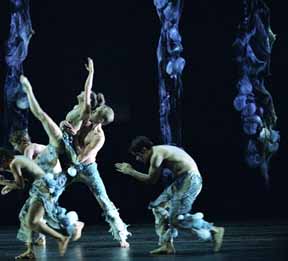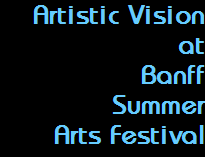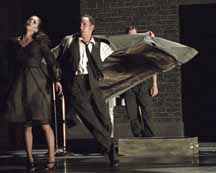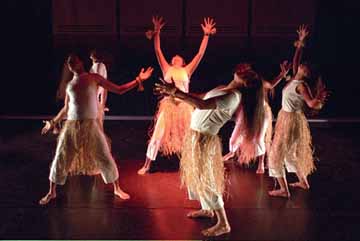



Alberta, Canada’s Banff Summer Arts Festival, set in a mountain range and close to pristine lakes and hot springs, is a tourist attraction, a production facility, an artist and writer’s colony, and an educational resource for scholars, professional and business people, elderhostelers, students and visitors from all over the world.
Banff hosts dance, theatre, opera, a film and video festival, multiple classical music, jazz and folk concerts, an Aboriginal Arts Program, a Cultural Journalism exchange, a Paradise Institute installation, where your sense of perceptual balance can be teased out of whack, and a slew of betwixt and betweens.
What Banff does best is support the development of artistic vision: Three creative efforts riveted my attention: Maelstrom (a dance-drama), The Aboriginal Arts Program, and Filumena – a new opera.
Maelstrom
Choreographer Andrew Giday’s dynamic interplay of contrasting elements, brought new life to the phrase dance-drama. Using sound and music from the album Weather by Michael Gordon and Lost Objects”from Bang On A Can, Giday created a movement logic all its own.  Maelstrom tells a story of a struggle to survive without telling a story. Through abstract imagery, wonderfully charged characters tossing about with an almost heroic will against odds, and elements of mysterious lyricism rising above the whirlpool of sensual dance and action, the work is a harvest of almost molecular expansion and contraction.
Maelstrom tells a story of a struggle to survive without telling a story. Through abstract imagery, wonderfully charged characters tossing about with an almost heroic will against odds, and elements of mysterious lyricism rising above the whirlpool of sensual dance and action, the work is a harvest of almost molecular expansion and contraction.
Maelstrom had the feel of an explosion of primal energy; the dramatic impact of a force of nature. Monoliths rose like distant shadows from the mountains outside. With a flickering suggestion of fetal energy, nude costumed figures struggled into the light under an umbrella of blue – slowly emerging into shape and form. The action expanded and receeded with compelling energy and touches of tender lyricism. Ending with a dancer left behind, collapsed on the floor, like a new born, exhausted.
Next a figure emerged cranking a wind machine – straight out of Dr. Caligari’s cabinet - creating bad weather at every turn. Another malovolent techie snapped away at a large tin thunder clap with feverish concentration. Both performers pressing on synergistically. Like two demi-gods having a field day. A thin perpendicular door center stage opened and shut in either direction.  A male dancer, in a Humphrey Bogart overcoat with collar turned up, flipped, twisted, tossed and sailed back and forth a female dancer. Like two crazy star fish looping in a continually shifting tidal wave of wind. The wind chill factor embraced all four struggling figures in a perpetual battle of will to get through the door one way or another.
A male dancer, in a Humphrey Bogart overcoat with collar turned up, flipped, twisted, tossed and sailed back and forth a female dancer. Like two crazy star fish looping in a continually shifting tidal wave of wind. The wind chill factor embraced all four struggling figures in a perpetual battle of will to get through the door one way or another.
As the balance between the dancers collapsed and expanded, they tossed about in betwildering exchanges. A machine-like balletic quality mesmerizing the movement. Everyone pitted together in a relentless attempt to leap beyond themselves into limitless freedom. Again the dark monoliths rose with fortress-like columns. The dancers unwinding in a chain of interlocking poses and leaps that trampled afoot any vestiges of gravity. A large mobile X above, like a pair of scissors, slowly shifted its balance, marking time leisurely. When the action receeded, no one remained. The dancers disappearing into the black hole - gone with the wind.
Giday has done extensive work as a dancer with French choreographers in Montreal and France. He attributes their emphasis on sensuality to the freedom he used to choreograph the violent but ultimately reconciling nature of his work. The scenic and lighting design by Harry Frehner, and the costume design by Deneen McArthur, contributed to the effect with imaginative visual nomenclature. But it was Giday’s risk taking that brought the bacon home.
The Aboriginal Arts Program
A remarkably foresighted and amazing woman, Marrie Mumford (Metis/Chippewa-Cree), in conjunction with an organization called Aboriginal Film and Video, started the the Aboriginal Arts Program at the Banff Centre 8 years go.  Mumford has a MFA from Brandeis and worked professionally in the theatre. Highly organized she can whip out events and statistics like a gourmet cultural cook. And if you try to get her to talk about her personal achievements, she will change the subject immediately. Although she is endowed with cross-cultural sensitivity, it is Mumford’s passion for the collective consciousness of aboriginal peoples that give her words authenticity:
Mumford has a MFA from Brandeis and worked professionally in the theatre. Highly organized she can whip out events and statistics like a gourmet cultural cook. And if you try to get her to talk about her personal achievements, she will change the subject immediately. Although she is endowed with cross-cultural sensitivity, it is Mumford’s passion for the collective consciousness of aboriginal peoples that give her words authenticity:
I traveled with traditional grandmothers of the Anishnaabe people. It has been said that the teachings of the Anishnaabe people go back 35 thousand years. The grandmothers were pushing for a vision for the next 7 generations. Why 7 generations? An Anishnaabe teaching. Seven fires, each fire a significant time in history. We are the 7th generation and we need to light the 8th fire. To find our way back to the red road.
In First Nation parlance, when the people are getting ready to move, a “runner” goes out ahead to prepare the selected place to move into. Marjorie Beaueage was the ground breaker for the Aboriginal Arts Project. When Mumford was hired full time in July, ‘95, the ground work was there and the vision collectively clear. First Nation artists and advisory councils from throughout Canada decided then that it was best to become “multi-disciplinary”.
Aboriginal self governance was in place.
Every 3 years, in a cycle of summers, young performers and their respected artistic mentors, develop original dance, theatre, music, and multi-media productions. All based on a variety of aboriginal performance traditions from Canada, the United States and abroad. As Mumford put it, the forms that emerge “affirm trust in Aboriginal process, and a deconstruction and revision of main stream practice”
This is a tough assignment. Student performers may drop by the wayside. Challenged by generational and cross-cultural exchange, and the desire to create new work, performers who stick to it for 3 years, end up staging a culminating production. Summer 2003 was the first addition of the latest three year cycle. It didn’t come easy, but it was all there. .
Choreographer Rosalie Jones/Daystar (Blackfeet/Chippewa) jump started the program with a dance work that employed the healing nature of dance into a sustainable expression of spiritual strength and lyricism.
Prayer of The First Dancer: Connecting Circles imagines a time “when there was no dance, no dancers, no reason to dance”.
 |
Opening with a single performer (Tanya Lukin) in silouhette, raising a hoop to the 4 directions, “Prayer of the First Dancer” rapidly engaged 13 performers with a spirited Navajo Beautyway Chant – narrated by Jones. Simple, eloquent movement developed into evolutionary dance patterns, colorful shawl dancing, fancy dancing, and celebratory pow wow singing. Accompanied by the evanescent heart beat of the drum, the choreography ended with a powerful prayer of reverence. .
At one point a young hip-hop dancer (Paul Campbell), working his way through the steps of hip-hop, broke into a break dance, and then into a free wheeling hoop dance. A magical moment of growth, of finding an unexpected way into cultural roots.
“Prayer For The First Dancer” topped off with a finale of interlocking circles of hoop dancing. Hoops snapping into place like a globe. Like the Earth snapping into place with its myraid of peoples.
Carlos Rivera Martinez’s From the Aztlan to the Zocalo is a Mexica (Aztec) work  exploring the mystical imagery of the Mexica journey from northwest Mexico to Tenochtitlan – now Mexico City .
exploring the mystical imagery of the Mexica journey from northwest Mexico to Tenochtitlan – now Mexico City .
Huitzilopochtili (Sinister Hummingbird) - Jennifer McLeod in startling face paint and the swift flash of a silvery costume - led the performers in a ritual journey from the known to the unknown – testing their fortitude.
This imaginative and well thought out work evolves through a series of concentrated and layered imagery. (the four directions: earth, wind, fire and water), a variety of dances from the Mexica tradition, and a signal that the journey had ended - an eagle in a cactus eating a serpent. The Mexica had finally arrived at Tenochtitlan. Here they would build a city on water - an architectural marvel of the first order.
The Aboriginal Arts Program has a mandate to assist in the development of indigenous traditional stories only when such a request originates from the tribal source. Columpa C. Bobb (Sto:Lo Salish), director and teacher, came with a 32 page script and requested an opportunity to “workshop” a portion of “Creation – My Mother’s Story”.
 |
The mandate was additionally fulfilled by the mother who appeared in person to pass on Salish traditional thinking about the role of family in “creation” – childbirth and the responsibilities of parents. Composer Russell Wallace’s primordial music, with haunting male and female singing voices, provided an embracing atmosphere for the development of the work. Through improvisation with the performers, choreographer Penny Couchie drew from the original source to capture appropriate movement qualities.
Future development will include the masking (in the West Coast tradition) of Sun, Moon, Raven and Moon/Spring, for greater character definition. Columpa Bobb’s work promises the opening of new doors in Canadian indigenous theater.
Muriel Miquel (Kuna/Rappahannock) of urban Spider Women fame, a performer of considerable comic achievement, is also a playwright with a powerful message of healing in mind. ”She Knew She Was She” is essentially a healing mission. A jingle dress story reshaped into a contemporary psychological context of growth and redemption.
Mortal Woman (Patii Shaughnessy) is unaware of the source of her despair. Surrounded by a “cloud of no seeing”, and lacking knowledge of where she is at and how she got there, she is stuck in one place unable to move. Urged on by a trio of spirited singers (The “Kokums”, or Grandmothers) – performed by the Edmonton singing group Asani – Mortal Woman is slowly rehabilitated. Lightning Woman (Melody Goodstriker)– a jingle dress dancer with an appropriate dual name – brought positive energy and the power of feminine spiritual intervention to Mortal Woman’s dilemna.
The lively performers also contributed a wickedly funny series of short entr’acts between scenes. A wacky salad dressing, thrown in for good measure, balancing outrageous humor with the serious in the best aboriginal tradition.
© 2003 AVIAR-DKA Ltd. All rights reserved (including authors’ and individual copyrights as indicated). All copyrights, trademarks and servicemarks are protected by the laws of the United States and Internalnational laws. Reproduction in whole or in part without permission is prohibited.
For permissions, contact publishers@scene4.com
All articles are archived on this site.
To access the Archives

SEPTEMBER 2003

